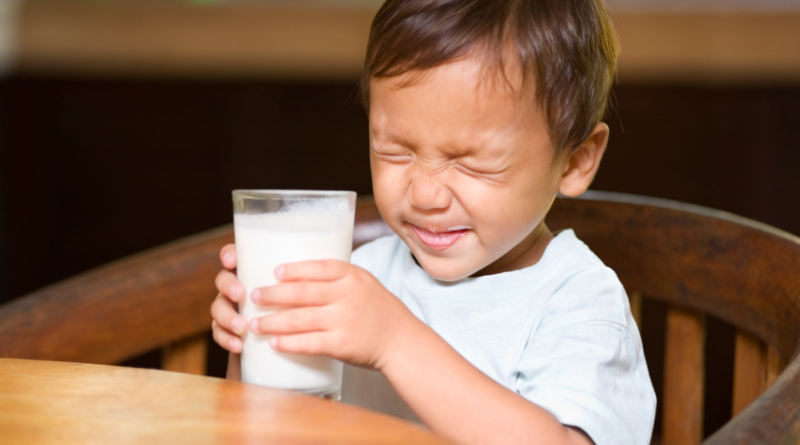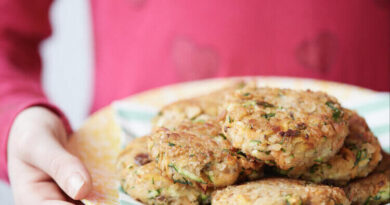What to do if your toddler won’t drink milk
We all know that milk is a staple for children but what do you do if your toddler won’t drink milk?
One of my children refused milk, and still hates most dairy foods to this day, so I understand.
Here’s what you need to know and what you can offer them instead to ensure they still meet their nutritional requirements.

Why milk is important for children
Its rich nutritional profile makes milk an excellent source of nutrients that are essential for children’s growth and development.
Nutritional Value of Milk:
- Calcium: One of the main reasons parents are encouraged to give their children milk is its high calcium content. Calcium is needed for the development and maintenance of strong bones and teeth. Calcium also has an important role in muscle function, nerve signalling, and blood clotting.
- Iodine: Often overlooked, yet iodine is a mineral found in milk that supports cognitive development. A deficiency in iodine during early childhood can lead to learning difficulties.
- Protein: Milk is a good source of protein, which is essential for building and repairing tissues.
During their rapid growth phase, children benefit from milk’s protein, which supplies essential amino acids to support development.
- Energy: Children need energy in order to play and learn. Milk is a great source of energy to support their activities.
However, while milk is beneficial, it’s not the only source of these nutrients. It is possible to ensure that children who might not enjoy milk still receive these necessary nutrients from other foods.

Which Milk is Best?
In the UK, children can have cow’s milk as their main drink after their first birthday. Before then it’s best to stick with breast or formula. It’s totally OK to continue breastfeeding beyond 12 months if you wish.
New evidence has suggested that cow’s milk can be either whole milk or semi skimmed but that lower fat milk or skimmed milk shouldn’t be offered as a drink until your child is 5 due to the lower calorie, fat and vitamin content.
However if your child is a fussy eater or you are concerned that they might not be getting the full range of nutrients from food, it’s worth remembering that whole milk contains more energy, omega 3, and vitamins A, E and K than semi skimmed.
Is Toddler Formula Necessary?
While the supermarket shelves are flooded with specialised toddler formulas, they are not actually necessary for most children.
If your toddler is not a fussy eater and is eating a balanced diet, they should be receiving all the necessary nutrients from food without the need for a specialised toddler milk.

How much milk should your toddler drink?
From the age of one to three, toddlers typically need about 350 mg (milligrams) of calcium a day, which equates to roughly 300ml (just over half a pint) of cow’s milk.
However, if a toddler is consuming other calcium-rich foods, this quantity of milk can be less.
200ml of cows milk can be swapped for 30g cheddar cheese or 125g milk based yoghurt to provide the same amount of calcium.

At what age can my toddler stop drinking milk?
While milk is a convenient source of nutrients, after your baby turns 1 year old, it isn’t a necessity in a toddlers diet.
If, for any reason, a toddler can’t or won’t drink milk they can still receive the necessary nutrients from a well-planned diet. Foods such as dark leafy greens, fortified cereals, fish, and seeds can supply calcium and other nutrients commonly found in milk.
In cases where cow’s milk is not suitable or not preferred, alternatives like fortified almond, soy, or oat milk can be considered. It’s crucial to check that these alternatives are enriched with calcium and other key nutrients, while noting they often have lower energy and protein content.

Why isn’t my toddler drinking milk?
Here’s some of the reasons why we often see that toddlers refuse milk.
Taste Preferences and Developmental Changes:
As toddlers grow, what was once a favourite flavour might now be met with dislike or even fear. This change in preference is entirely natural and is a part of food neophobia where toddlers enter a new developmental stage which includes a fear of trying new foods.
Appetite Fluctuations:
Just like adults, toddlers have days when they’re hungrier and days when they’re not. Growth spurts, activity levels, and even mood can influence their appetite. So, if your toddler skips their milk one day, it might just be because they’re not that hungry.
Parental Expectations:
Sometimes, our expectations as parents might not align with our toddler’s actual needs. We’re you surprised to learn how little they actually need by the age of 1? While milk is nutritious, expecting a toddler to drink milk every day might be unrealistic for them, especially if they’re getting their nutrients from other sources.
Influence of friends and siblings
Toddlers are observant. If they notice a friend or an older sibling refusing milk or favouring another drink, they might copy that behaviour.
Past Negative Experiences:
A single or repeated negative experience, such as a stomach upset after drinking milk, can have a lasting impact. Consequently, toddlers might associate milk with that unpleasant feeling and refuse it to avoid a repeat of the experience.
Some toddlers may be allergic to cow’s milk proteins, with symptoms varying from mild hives to severe anaphylaxis. Therefore, if your toddler shows discomfort, swelling, or any allergic response after milk consumption, consulting a doctor is crucial.

How to get your toddler to drink milk
Encouraging a toddler to drink milk can sometimes require a blend of creativity, patience, and understanding their preferences. Here are some tried and tested methods to make milk more appealing to your little one:
Mixing Milk with Other Foods or Adding It to Favourite Meals:
- Porridge: Use milk to prepare their morning porridge, enhancing it with fruits or a touch of honey.
- Soups: Creamy soups, such as tomato or mushroom, can be made richer with milk.
- Mashed Potatoes: Swap water or stock with milk for a creamier texture in your mashed potatoes.
- Milk jelly: A fun way to include milk is with a milk jelly
Milk Jelly Recipe
Ingredients:
- 500ml whole milk
- 2 gelatine sheets or equivalent gelatine powder
- 2 tablespoons of sugar (optional)
- A drop of vanilla extract (optional)
Method:
- Soak the gelatine sheets in cold water for about 5 minutes.
- Warm the milk in a saucepan without boiling.
- Add the softened gelatine to the milk, stirring until dissolved.
- Mix in sugar and vanilla extract if desired.
- Pour into moulds or a bowl and refrigerate for at least 4 hours.
- Serve chilled.
Change the Temperature
Some toddlers prefer their milk warm, reminiscent of their breast/bottle feeding days, while others might like it cold. Experiment to find your child’s preference.
Use a Fun Cup
- Cup Type: The type of cup can make a huge difference. Some toddlers might prefer a sippy cup, while others might be more inclined to drink from a regular cup or one with a built-in straw. Finding a cup in a favourite colour or character can also be helpful.
- Blowing Bubbles: By making milk enjoyable, such as letting your toddler blow bubbles in it, you can often motivate them to drink more.
- Cereal Bowl with Straw: Consider serving cereal with milk in a bowl that has a built-in straw. Once they finish their cereal, they can drink the remaining milk directly from the bowl, making it a fun experience.

Can You Add Milkshake Powder to Toddler’s Milk?
Yes you can. Milkshake powders will change the taste, but many contain added sugars and artificial ingredients. They are also an ultra-processed food.
If you opt to use them, choose a brand with minimal additives or consider a more natural homemade milkshake using different fruits blended with milk.
Easy Banana-Strawberry Milkshake
Ingredients:
- 1 ripe banana
- 3-4 fresh strawberries
- 200 ml whole milk
Instructions:
- Prepare the Fruit:
- Peel the banana and cut it into chunks.
- Wash the strawberries and remove the stems. Cut them into halves.
- Blend:
- Place the banana and strawberries into a blender.
- Pour in the milk.
- Blend the ingredients on high speed until smooth. If the shake is too thick, you can add a little more milk to reach the desired consistency.

What to give toddler who won’t drink milk
For parents concerned about their toddler’s refusal to drink milk, there are plenty of alternatives that can ensure they still receive the nutrients they need for healthy growth and development.
Here are the key nutrients found in milk and some non-milk alternatives:
Calcium:
Leafy green vegetables like kale and spinach, fortified cereals, almonds, sesame seeds, and tofu are sources of calcium.
Iodine:
Shellfish, fish, eggs, and prunes are rich in iodine.
Protein:
Meat, poultry, fish, eggs, beans, lentils, and chickpeas are all rich in protein.
Calories:
Avocado, nuts, seeds, and whole grains can provide the necessary calories for a growing toddler.

15 milk based recipes for toddlers
Here are my 15 top recipes for getting milk and milk based foods into your toddlers diet.
- Macaroni cheese A classic favourite, macaroni cheese is rich in calcium and comforting for toddlers, with milk hidden within the creamy cheese sauce.
- Chicken in milk This cooking method tenderises the chicken and infuses it with calcium and protein from the milk, making it a nutritious and palatable dish for little ones.
- Potato and Leek Soup A creamy soup that’s not overpowering in taste, providing nutrients from milk without a strong dairy flavour.
- Savoury Pancakes You can pack these with veggies for added nutrition, and the milk in the batter ensures a soft texture that toddlers find easy to eat.
- Creamy Porridge A warm and soothing breakfast option, porridge made with milk is a comforting way to start the day, rich in energy and essential vitamins and with plenty of topping ideas.
- Coconut Milkshake For those who prefer sweet over savoury, this milkshake disguises the milk among the beloved flavours of coconut.
- Cheesy Scrambled Eggs Eggs, rich in protein, become even more nutritious when milk is added, softening the scramble and boosting the meal’s calcium content.
- Milk Rice Pudding A simple way to get more milk into a toddler’s diet in a dessert-like form.
- Creamy Tomato Soup The milk in this soup adds a creamy texture and a dose of calcium, making it more nutritious than a standard tomato soup.
- Cauliflower Cheese This dish turns a simple vegetable into a creamy, cheesy delight, with milk adding both flavour and nutritional value.
- Creamy Vegetable Mash A versatile dish that can include a variety of vegetables, the addition of milk ensures a creamy texture and helps with the intake of calcium.
- Creamy Tuna Pasta Bake A comforting casserole that includes milk in the sauce, providing a comforting and calcium-rich dish.
- Fruity milk jelly A fun and jiggly way to enjoy milk, with the natural sweetness coupled with vitamins from fruit.
- Cheese & Veggie Omelette The milk in the omelette adds fluffiness and ensures that the dish is moist and soft, perfect for toddlers.
- Peanut butter whip with apple slices, a lovely combination of Greek yoghurt and peanut butter with a touch of honey (over 1’s only).

The post What to do if your toddler won’t drink milk appeared first on The Children's Nutritionist.




